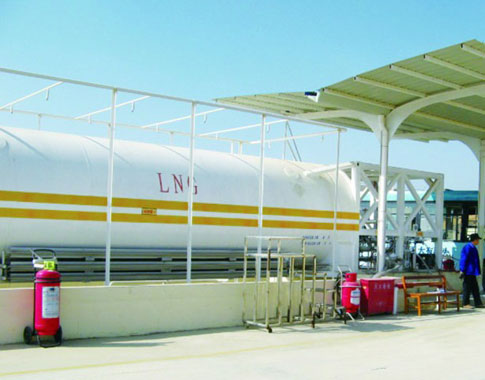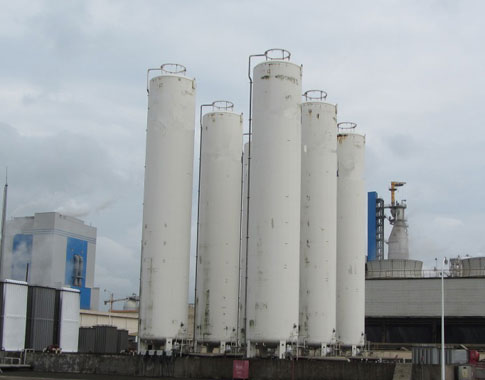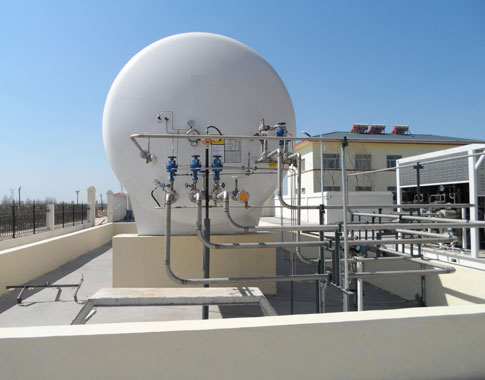



1. LNG refueling station Introduction:
After purification by natural gas (removal of CO2, sulfur compounds, heavy hydrocarbons, water and other impurities), at atmospheric pressure cryogenic at -162 ℃, by the gas into a liquid, called liquefied natural gas, the volume of LNG is about the same the quality of natural gas volumes 1/620, weighs about the same volume of water is about 45%.
Designed and built by Cryostat, LNG stations deliver natural gas for refueling vehicles, either in liquid or gaseous form, or combined. Liquid natural gas (LNG) is stored in a cryogenic tank and then pumped directly to a dispenser for liquid delivery. Alternatively, it can be pressurized and vaporized for delivery as compressed natural gas (CNG).
Storing natural gas as a liquid instead of a gas greatly increases supply flexibility. Natural gas decreases about 600 times in volume when liquefied, which makes transport and storage much more efficient and cost-effective.

2. Classification:
LNG supply liquefied natural gas filling stations LNG filling stations, divided into four types, which are generally divided into:
● Skid-mounted stations
● The standard formula stations
● L-CNG filling stations
● Skid-mounted mobile stations

3. LNG station consists of:
● A cryogenic storage tank for LNG; typical size 60-70m³
● A cryogenic submerged centrifugal pump skid for transferring the LNG
● System featuring patented equipment to convert cold liquefied natural gas to saturated LNG at a higher temperature
● Weights and measures certified dispensers for LNG, connected to a payment system
● Flow management skid for easy future extensions to the LNG station
● LNG cooling system using patented equipment to deliver cold LNG and eliminate the risk of gas being released from the storage tank
● Gas and leak detection equipment
● Complete PLC control system supporting remote access

4. LNG station specification
Specification of LNG storage tanks :
| Item | specification |
| Role | for LNG liquid storage |
| Shape | vertical tank / horizontal tank |
| Insulation | vacuum powder (perlite) |
| Winding | glass fiber |
| Daily evaporation rate | <0.3% |
| The designed maximum working pressure | 1.2MPa |
| Safety valve opening pressure | 1.25MPa |
| Proof pressure | <1.6MPa |
| Design temperature | -196 ℃ |
| Working temperature | -162 ℃ |
Specification of Pumps and submersible pump skid
| Item | specification |
| Working medium | LNG |
| Aerated speed | 3 ~ 80kg / min |
| Measurement accuracy | 1.0 |
| Repeatability | 0.5% |
| Working pressure | 1.6MPa |
| Design temperature | -196 ℃ ~ 55 ℃ |
| Design | Vacuum Module |
| screen | High brightness large-screen display, adjustable units of measurement |
| protection | Dual pull off |
| Standard | vacuum filling hose |
| printer | Small label printer with optional explosion |
| Keyboard | Metal Keyboard Configuration |
Specification of Skid mounted pump
| item | specification |
| Working medium | LNG |
| Filling speed | ≤160kg / min |
| Working pressure | ≤ 1.6MPa |
| Design temperature | -196 ℃ ~ 55 ℃ |
Specification of cryogenic submersible pump
| item | Specification |
| Transmission medium | LNG |
| Flow | 340L / min |
| Motor power | ≤11KW |
| Speed | 1500 ~ 6000r / min |
| Pool pump working pressure | 1.6MPa |
| Evaporation Rate | ≤ 50% / d |


5. Safety Knowledge:
(1) LNG has a very low atmospheric pressure at ambient temperature: -162 ℃;
(2) With great gas-liquid volume ratio, if inappropriate measures pressure will lead to pressure rise rapidly. LNG gas-liquid volume ratio of approximately 620: 1;
(3) pre-fill a small amount of natural gas loss rate of vaporization larger return result;
(4) Within the city unavoidable presence LNG vehicle emission problems;
(5) Natural gas is a combustible gas, the production area has obvious security identity;
(6) Skid-mounted LNG refueling stations should have a comprehensive safety measures and fixed-point using do not just move to use a vacuum process piping is not allowed treading;
(7) Non-collision during transport tanks, tank must maintain a vacuum degree;
(8) Maintaining equipment ventilated area;
(9) To ensure that during repair or maintenance of the system is the pressure relief device;
(10) Away from flammable materials or spark;
(11) Electrical parts, and instrumentation, some not water;
(12) All electrical equipment in hazardous areas shall comply with the requirements Explosion levels;
(13) There are LNG in the region, you cannot use open flame or any unauthorized electrical and communications equipment, such as mobile phones and radio transmitters. Precautions
Make sure you do not miss any news. Sign up today!



